6sense vs Zoominfo Compared: What to Know Before Buying
If you're deciding between 6sense and ZoomInfo, you're probably deep into building (or fixing) your ABM strategy.
Both tools promise to help you find, prioritize, and convert your ideal buyers. ZoomInfo delivers contact data and enrichment, while 6sense gives you intent signals and predictive insights.
But they also share a critical blind spot: they only go as far as the account level.
If you want to run ads, track engagement, or support Sales with actionable intel, you’re still left guessing who’s actually engaging and how to follow up.
That’s where contact-level visibility comes in. And that’s something you’re only going to get with Influ2.
Let’s break down how 6sense and ZoomInfo compare—what each one does best, where they overlap, and what’s still missing if you’re trying to influence real buyers across the entire buying journey.
6sense vs. ZoomInfo: The TL;DR
Before we dive deep, here’s a quick overview of both tools:
| 6sense | Zoominfo | |
| Primary focus | All-in-one ABM platform with predictive intent and account scoring, heavily based on proprietary AI models. | Data intelligence platform with a huge B2B contact/company database. |
| Intent data | Collects first- and third-party signals from web activity of target accounts, and uses AI to score them. | Provides intent signals (site visits, content consumption, news) layered over its data. |
| Advertising and targeting | Built-in B2B programmatic ad engine. Quick integration to ad channels. | Ads are run to custom audiences built from ZoomInfo data. |
| Contact and enrichment data | Account-level profiles with firmographics and intent; smaller contact database. | Large contact and company database with automated enrichment and org charts. |
| CRM/MA integration | Connects to Salesforce, Dynamics, HubSpot, Marketo, Pardot, etc. Can auto-fill forms and sync account scores. | Connects to Salesforce, HubSpot, Marketo, Pardot, etc. Syncs updates and enriches records automatically. |
| Conversational intelligence | No | Yes |
| AI-powered sales Copilot | Yes | Yes |
| Best for | Enterprise teams focused on ABM and predictive analytics. Ideal when you need deep account insights, prioritized outreach based on intent, and ad optimization. | Teams that need a broad pool of high-quality data for prospecting, enrichment, and demand generation. Excels at finding contacts and firmographics quickly. |
Comparing 6sense and ZoomInfo: Where Each Tool Sits in a Marketer’s Stack
Let’s be clear: this is not an apples to apples comparison.
In the space of ABM, 6sense and ZoomInfo play different but overlapping roles.
6sense is an all-in-one ABM platform, built mainly to help you identify target accounts that match your ICP, and monitor their online activity to see if they have intent signals. It also allows you to organize your ABM campaigns, especially ads.
ZoomInfo, on the other hand, is a data intelligence platform, best known for its huge database of companies and contacts. It offers lead enrichment tools, helping you identify companies that match your target audience, and then get contact information for the individuals you want to sell to in that company.
Let’s talk about the main differences in the areas where they overlap the most.
Intent data and buying signals
Both 6sense and ZoomInfo aim to surface accounts that are actively researching your industry or competitors, but they go about it differently.
6sense leans on AI to fuse first-party data (like visits to your website, updates in your CRM, etc.) with their database of third-party signals, and turn those signals into predictions of when an account is ready to buy (or even predict which stage of the buying process they may be in.)
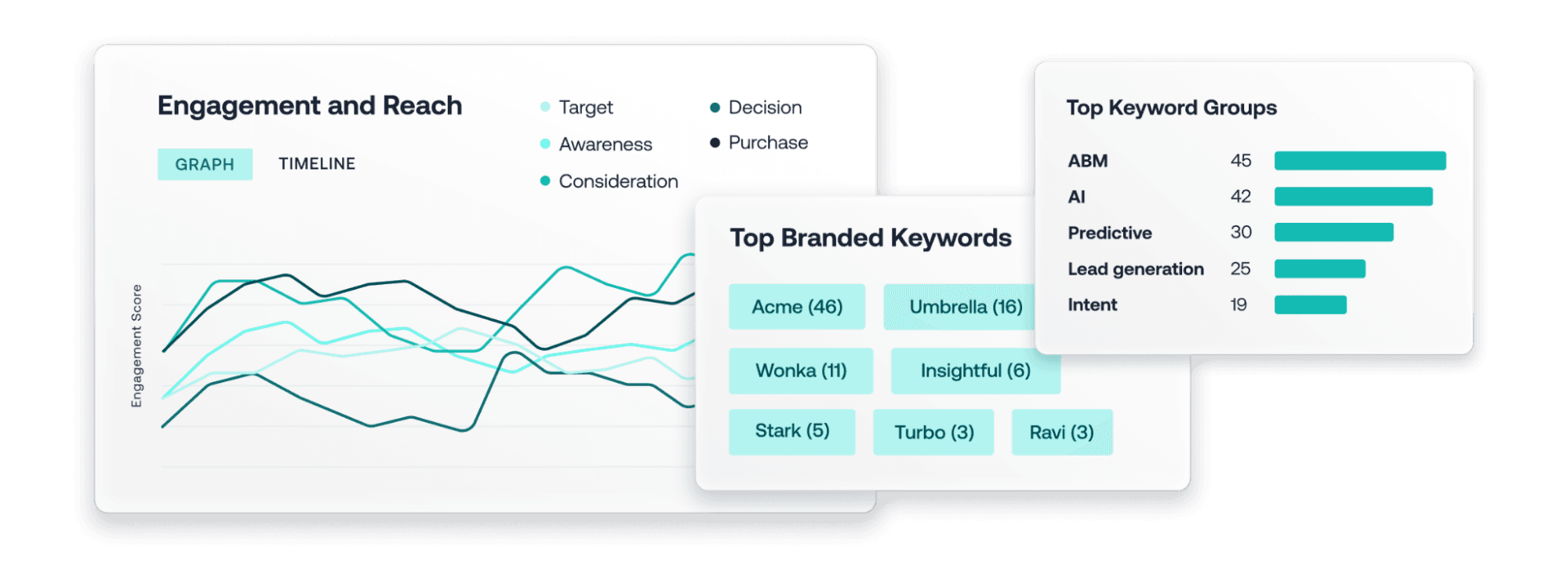
Here’s what that looks like:
- First- and third-party data: 6sense ingests your CRM/MAP engagement plus partner network data and web activity to build an overall view of account behavior.
- AI-driven scoring: Using their proprietary machine learning models, 6sense attempts to predict when an account is more likely to convert, so you’re not just seeing raw page views but a prioritized list of potentially warm accounts.
- Actionable alerts for your sales team: Both marketing and sales teams can get notifications when an account hits the intent threshold you set, meaning both teams can act quickly when there’s more interest.
- Built-in orchestration and automation: You can use 6sense’s intent data in their automated workflows, meaning when a new account hits an intent score threshold, they’re automatically added to a sales workflow, ad campaign, or even enriched with more data.
ZoomInfo layers intent indicators on top of its huge firmographic/contact database, giving you a quick view of “who’s searching what” on the internet.
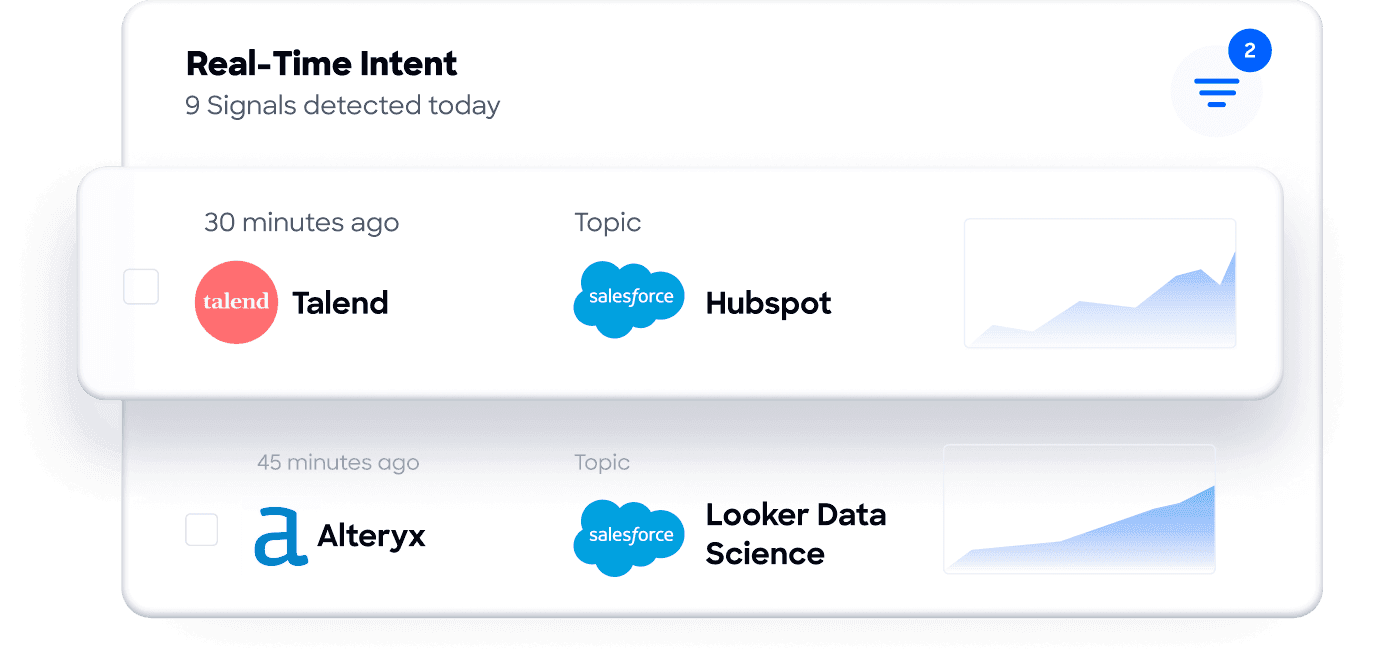
This includes:
- Signal Score and Audience Strength: Signal Score is a number that tells you how interested a company is in the topic, compared to their historical baseline. Audience Strength tells you the size of the group at this company researching this topic.
- Guided Intent: This AI-powered product is like a time machine that analyzes your first-party CRM data and determines which intent topics had the most impact in creating past opportunities.
- Rich firmographic filters: Over 300 attributes (industry, revenue band, tech stack) let you slice intent-active accounts with surgical precision before activating campaigns.
- Plug-and-play segments: ZoomInfo offers prebuilt intent-driven audience templates, which means you can launch targeted campaigns quickly, even if you’re not an AI wizard.
Key takeaways:
- 6sense delivers deeper ML-driven intent scoring; ZoomInfo offers broader, quicker intent layering on top of its massive database.
- Use 6sense to predict when accounts are in-market, versus ZoomInfo to catch who is browsing right now.
- 6sense embeds intent into your CRM workflows, while ZoomInfo feeds intent into its MarketingOS or an external DSP.
- 6sense often requires a long ramp-up (including training the predictive model to your own specifications), whereas ZoomInfo’s intent data can be used almost right out of the box.
Here’s what both 6sense and ZoomInfo are missing
With platforms like 6sense and ZoomInfo, you’re limited to account-level intent data—and only when those accounts are actively in-market for the topics you’re tracking.
That’s helpful, but it also means you’re waiting for signals that might come too late.
The bigger gap? You have no visibility into which specific people are showing interest. And more importantly, no way to proactively engage them.
To truly influence the buying process, you need to go beyond accounts and get in front of individual decision-makers early—with messaging tailored to their role and context. That’s where Influ2 comes in.
Influ2 is the only solution that gives you contact-level advertising and intent signals tied to actual people. It allows you to target named buyers directly, build awareness, and track engagement at the individual level—so you're not guessing who’s interested. You know.
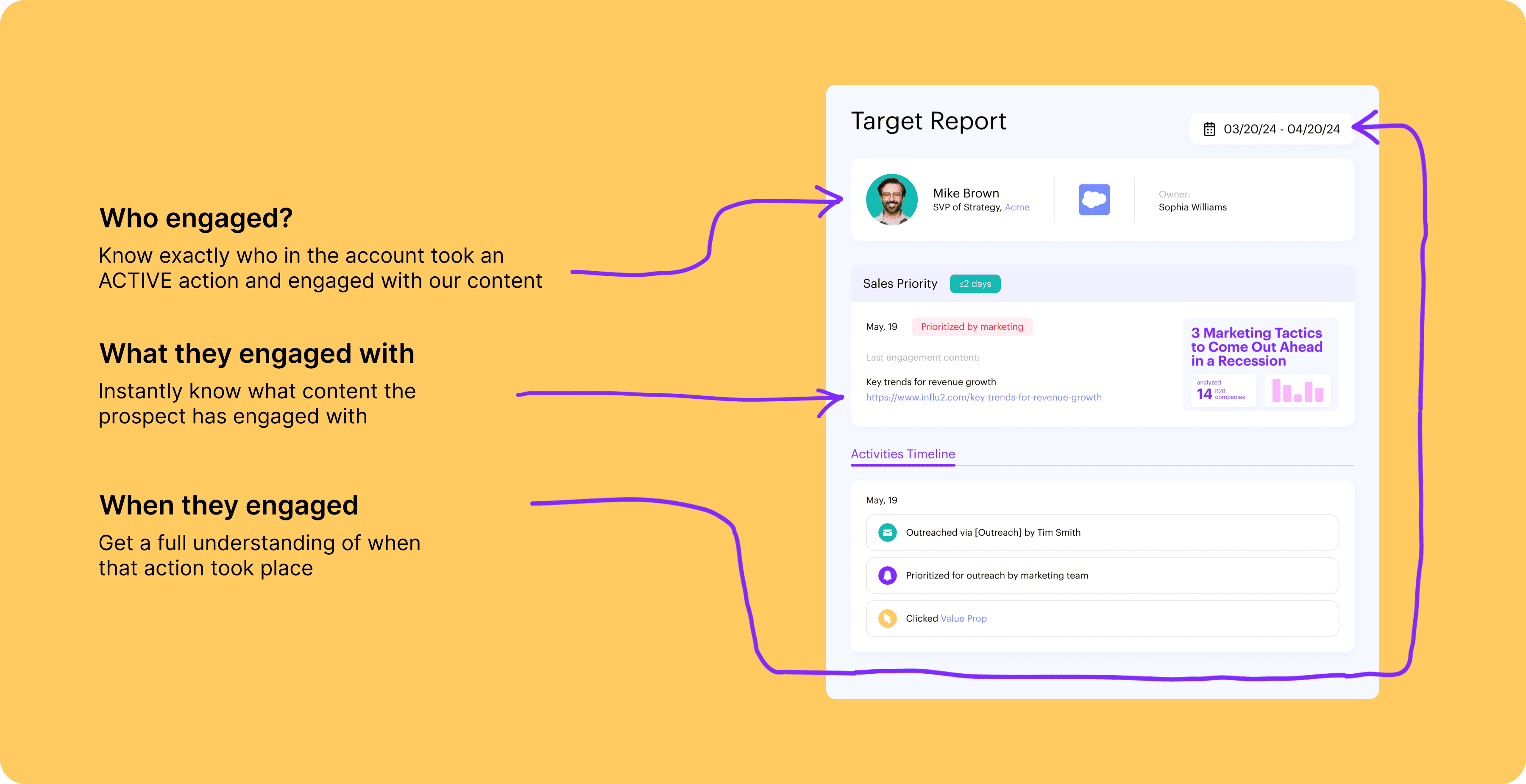
Account identification and data enrichment
Knowing which accounts fit your target audience, and how to get in touch with them, is essential for ABM. Both 6sense and ZoomInfo help you find and flesh out target accounts—but one leans on AI workflows while the other flexes its encyclopedic contact database.
6sense account identification and targeting is based on the criteria that you set plus its own predictive models. You build your ICP, and 6sense will help you identify accounts that match.
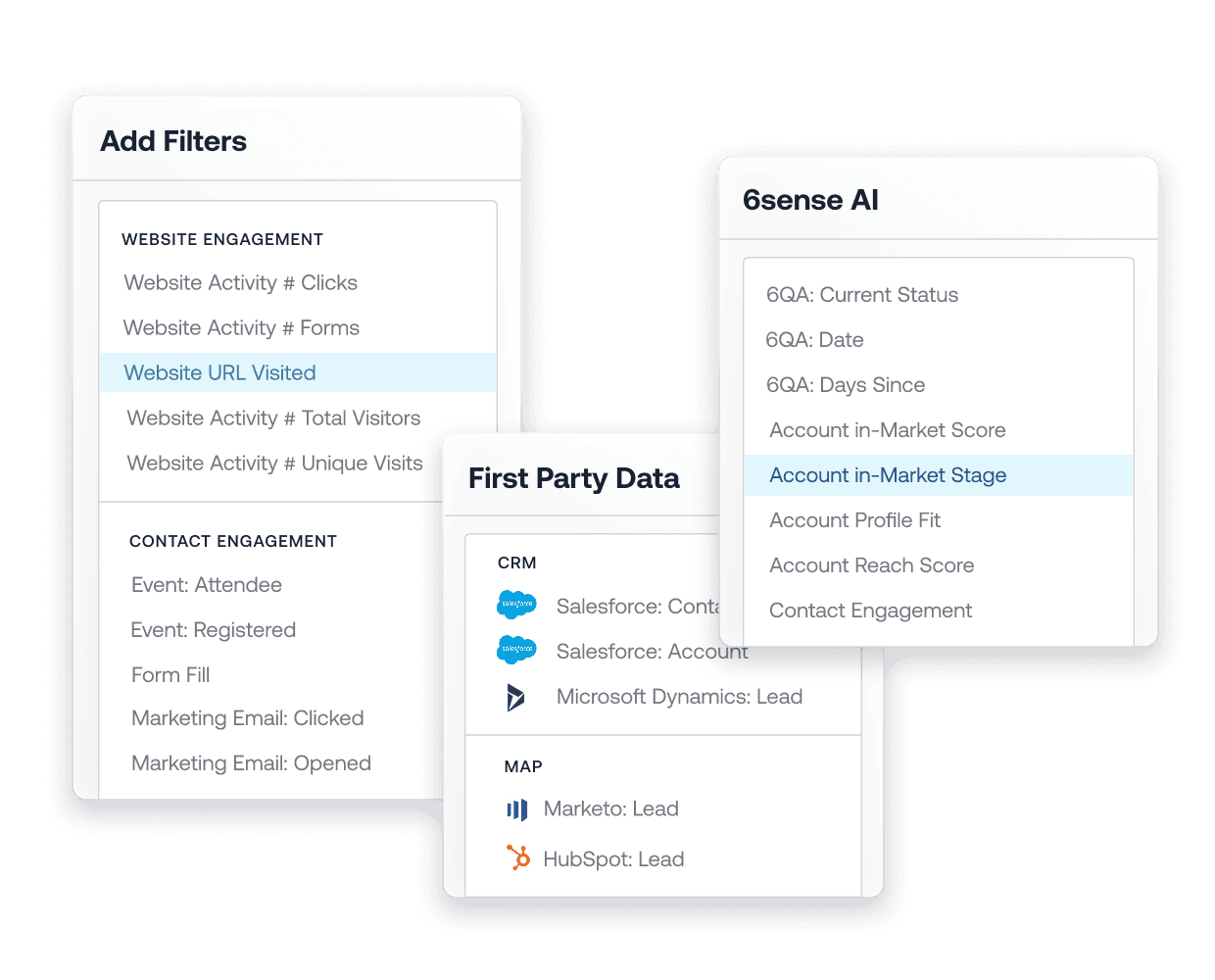
This includes:
- Audience Builder: 6sense offers 80+ filters to choose your audience, including firmographic, technographic, and behavioral filters. This combines company data with intent signals to give you a list that’s focused on the warmest leads.
- Intelligence workflows for enrichment: 6sense offers a drag-and-drop workflow builder for ABM teams, meaning you can set up rule-based enrichment that refreshes account and contact records based on a variety of triggers. For example, when an account that matches your ICP hits a certain intent threshold, you can set up a workflow to enrich that account with firmographic data.
- Dynamic segments: As new accounts match your criteria or hit thresholds for intent, your segmented audience lists will automatically update, meaning you’ll always have fresh leads on hand.
ZoomInfo is basically a B2B library, storing millions of data points about companies and the people who work for them.
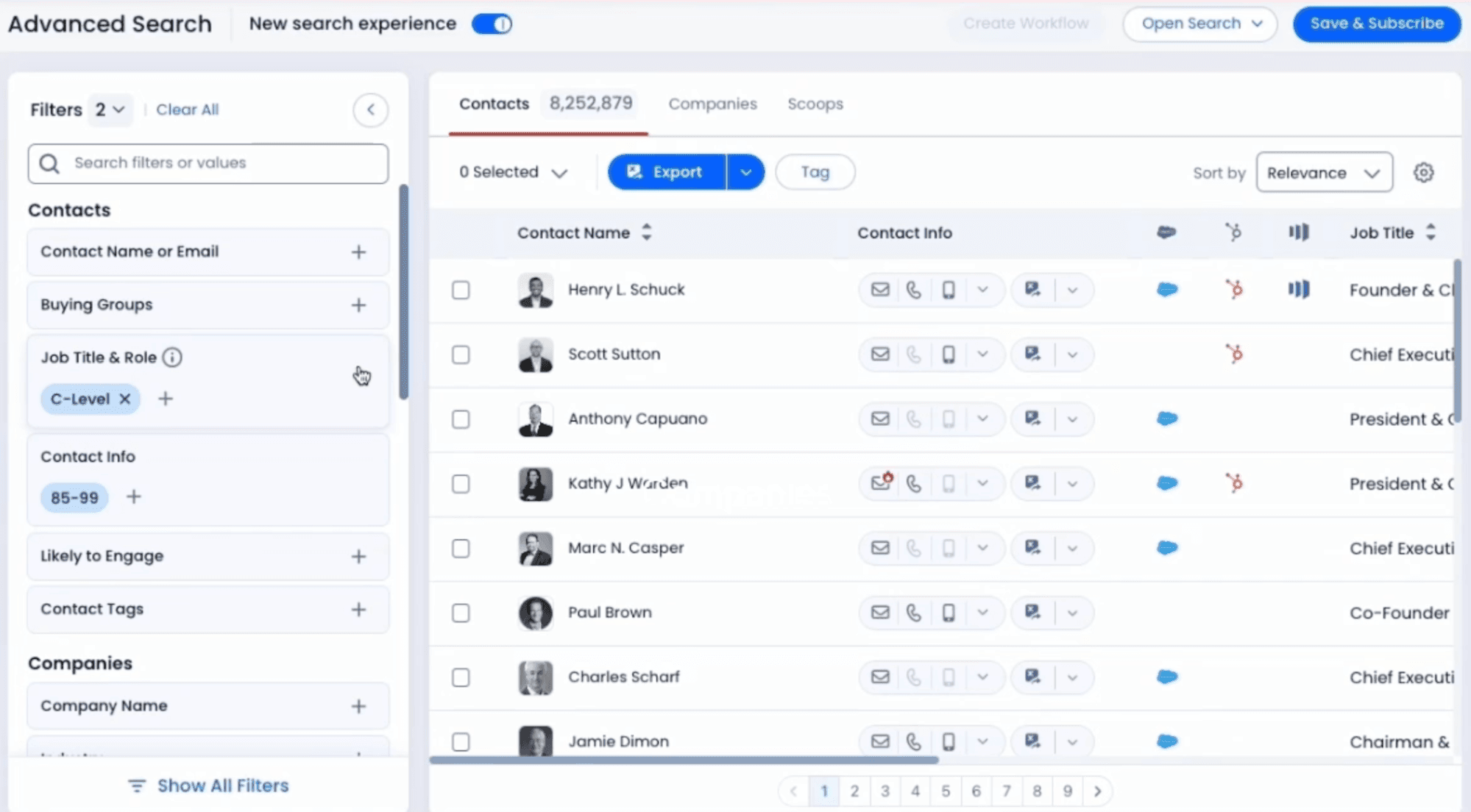
Here’s what you’ll get:
- Mega-scale contact pool: Tap into 174 million email addresses and 94 million direct phone numbers for B2B contacts.
- Multi-source data curation: Info is pulled from public records, business websites, annual reports, and verified user contributions—so you’re not just relying on one crystal ball.
- Firmographics and technographics: Company size, industry, tech stack—ZoomInfo has it.
- CRM sync and data cleanup: Native integrations with Salesforce, HubSpot, Marketo, and Pardot auto-enrich and de-duplicate records (so your database can stop looking like that messy drawer of takeout menus in your kitchen).
As one user says: “You can find 90% of your desired contacts in seconds. I’ve run lead generation for multiple companies in tandem with sales and marketing, and ZoomInfo has been the best tool.”
Key takeaways:
- ZoomInfo has best-in-class contact and firmographic data, with some of the best ratings for accuracy and volume.
- 6sense is best for applying AI to those accounts and knowing which accounts to target. It doesn’t have the extensive database that ZoomInfo does, but its use of predictive models gives you more insight from the data it does provide.
Advertising and targeted campaigns
When it’s time to get your message in front of the accounts that matter, both of these tools can help, but they wear different hats.
6sense has a built-in DSP (demand-side platform), so you can create campaigns directly inside this tool. It’s specifically built for B2B ABM, so you can go from intent signals to ad spend without ever leaving the platform.
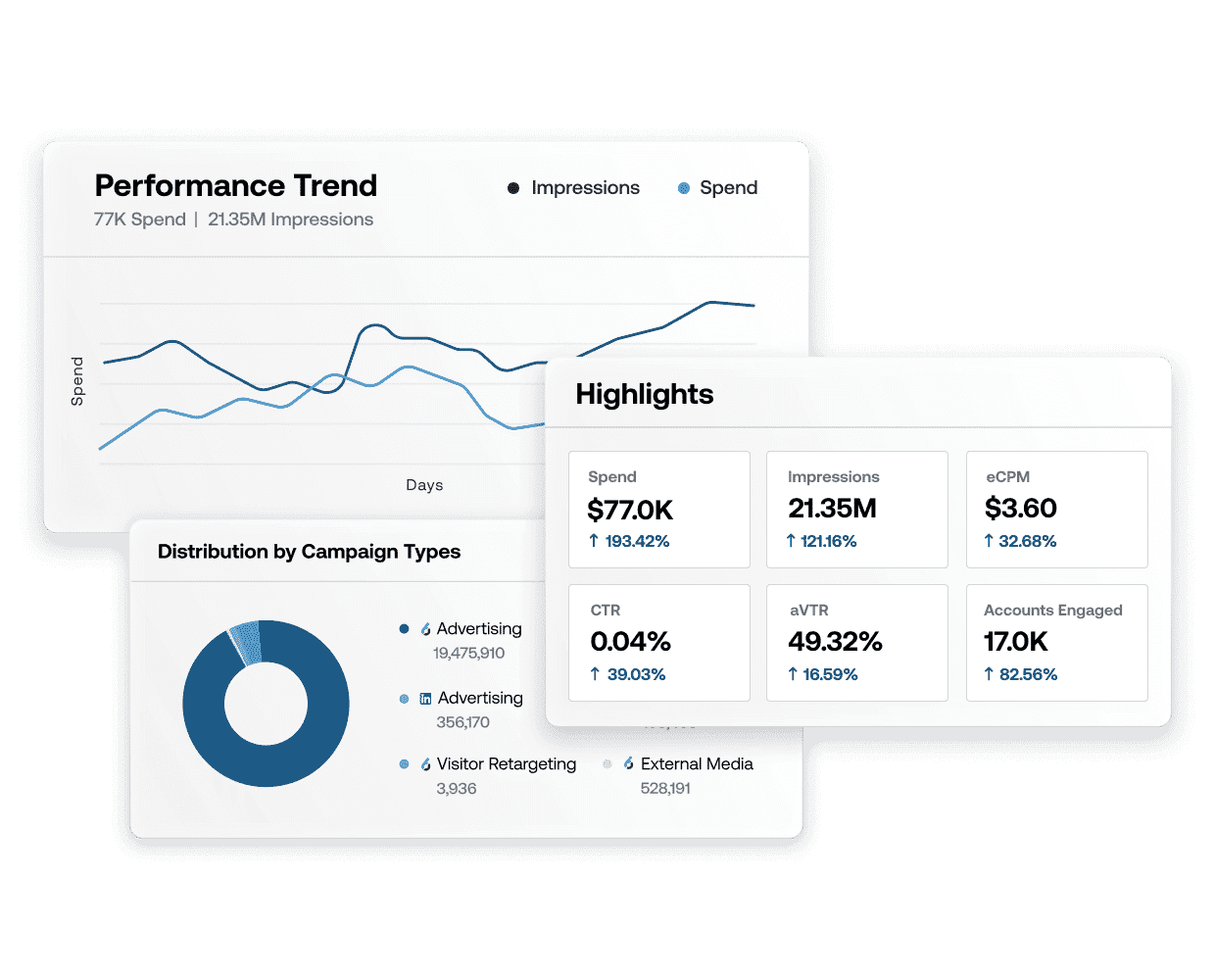
Here’s what it looks like:
- Built-in B2B DSP: Connects directly to major ad exchanges, no extra tools required.
- Multi-format support: You can run traditional banners, HTML5, video, native, and social ads all from one interface.
- In-platform campaign builder: Launch display, retargeting, contextual, and LinkedIn campaigns with customizable flight dates, budgets, frequency caps, and real-time alerts.
- AI-optimized delivery: With predictive account scores and intent signals, 6sense can prioritize ad spend on accounts that are more likely to convert.
ZoomInfo has partnered with The Trade Desk to offer its own native DSP inside its MarketingOS product.
Here’s what they provide:
- All-in-one DSP features: Manage ad inventory, bidding strategies, customer segmentation, and reporting directly inside ZoomInfo.
- Granular targeting: Filter by job title, seniority, department, technology, or any of the 300+ attributes to reach the right roles within target accounts.
- Audience targeting that leans heavily on their databases: ZoomInfo learns from what you identify on their platform as good-fit customers. Then, it removes any personally identifiable information from that data, turning the dataset into something that can be used for advertising across different platforms. The goal: to get you closer to the accounts and people you want to target.
Key takeaways:
- 6sense is built from the ground up for B2B ABM campaigns; ZoomInfo layers DSP capabilities into its contact and intent data.
- 6sense tightly weaves account scoring and predictive modeling into its ad delivery; ZoomInfo focuses more broadly on the types of accounts and roles you want to target based on its database.
The missing piece in 6sense and ZoomInfo’s advertising capabilities
While 6sense and ZoomInfo offer powerful insights and account targeting, there’s one major limitation: neither platform lets you target individual people with advertising. You’re still speaking to accounts, not to the actual decision-makers inside them.
And that’s a problem because B2B buying decisions are made by people, not accounts.
To close that gap, you need a way to see what individual buyers at your target accounts care about.
That's what separates Influ2 from tools like 6sense and Zoominfo.
Influ2 offers contact-level ABM. Unlike traditional ABM tools that tell you "someone from Acme is showing intent", Influ2 shows you "John B from Acme searched {Keyword}".
You can get these contact-level intent signals across search, social, and third-party content. Check out how it works here.
You can also deliver contact-level ads to specific individuals across LinkedIn, Google, Facebook, and more—then see exactly who engaged, so Sales can follow up with context.
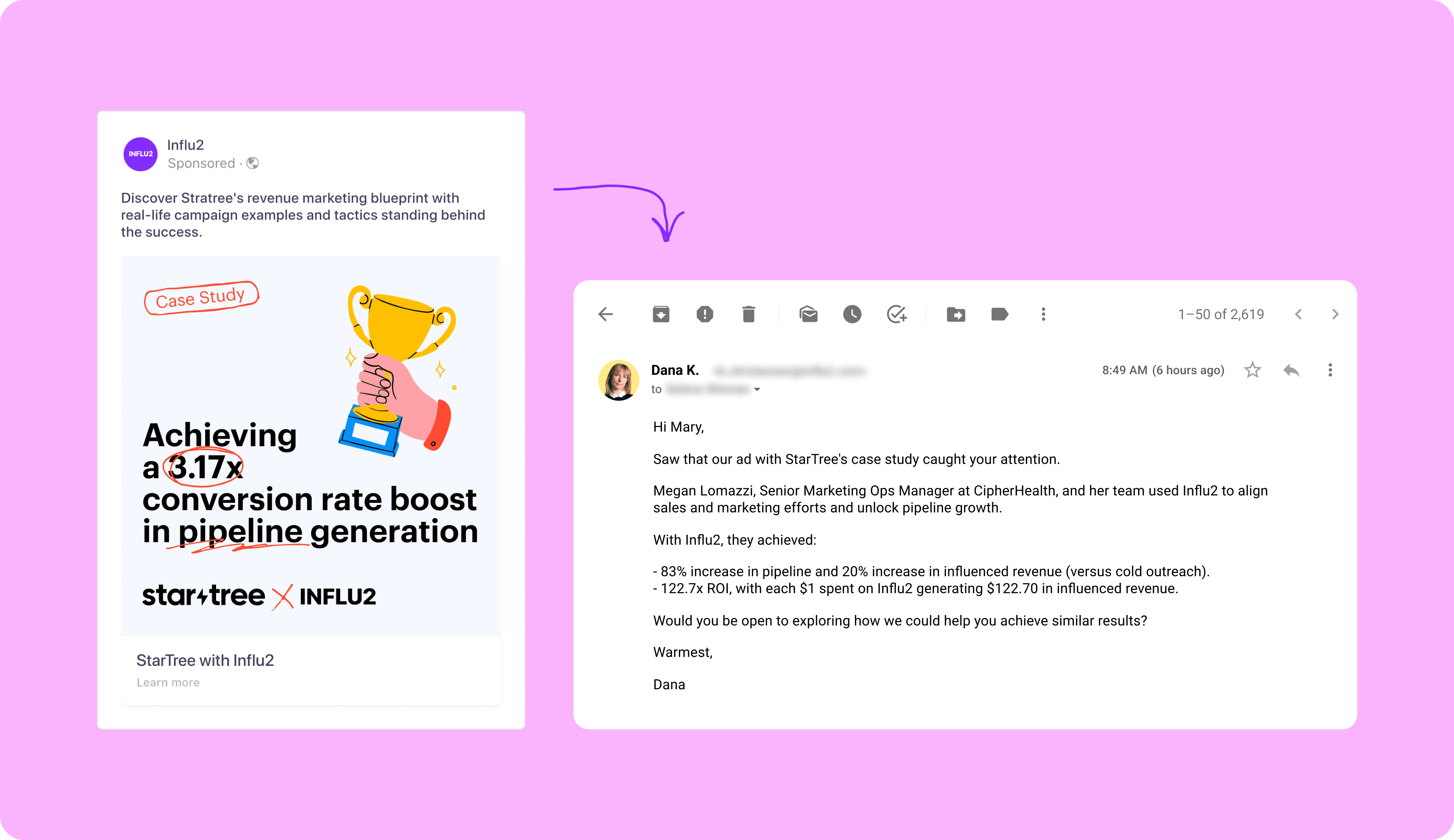
Data accuracy and usability
When choosing a tool like these, data accuracy is always a concern. And let’s be real: there is no perfect option.
Neither 6sense nor ZoomInfo claim their data is 100% accurate (because really, that would be absurd). Especially in the tech world, where turnover is high and companies make big changes at the drop of a hat, the data is constantly changing, and it’s impossible for any tool to keep up.
That said, here’s how ZoomInfo and 6sense compare when it comes to data accuracy and usability (according to real users).
6sense’s data comes from a variety of sources, including a myriad of data partners. That means the accuracy of their data is really dependent on how committed their partners are to cleansing and updating that data.
Reviewers point out a few wrinkles here, the most common theme being complexity.
Many users love 6sense’s overall power as an ABM tool, but complain about a significant learning curve, especially during implementation.
Users mention that it’s not the most intuitive system out of the box, and it requires a long-term investment in time and energy to get going and maintain.
In general, ZoomInfo is praised for its data accuracy and freshness, especially on those big whale accounts. It offers alerts on funding events or new hires, so data is kept up-to-date.
One user says the platform “keeps our team connected with the industry…keeping the data we act off of as timely and accurate as possible.”
That said, not all the data is perfect.
In particular, contacts at small firms seem more likely to get stale. Reviewers note that you can sometimes find outdated emails or duplicate organization records.
Key takeaways:
- ZoomInfo is generally easier to use out of the box, but can also be complex to learn for smaller teams.
- The payoff with 6sense is usually higher, if your whole team is willing to put in the effort to climb that learning curve.
Want to get the most accurate data?
The most accurate data you can get is first-party data—the kind that comes straight from your website, CRM, or ad campaigns.
That’s where Influ2 can help.
Once you have a list of contacts to target, you can use Influ2 to deliver ads to those individuals. When they engage with your ads and landing pages, you’ll have direct, first-party data to show intent. That’s the kind of data your sales team can take action on.
Sales-specific features for direct outreach
Your ABM efforts are the support your sales team needs to target the right accounts, outreach warm contacts, and ultimately close deals.
So, the tools you use should also offer support for your sales team.
Here’s how 6sense and ZoomInfo compare.
6sense’s Sales Intelligence and Sales Copilot are based on AI and predictive analytics, turning the data it collects into action items for your sales team.
This includes:
- Account prioritization: Highlights the accounts that are most likely to convert based on intent signals, so reps focus on opportunities that are more likely to pay off.
- Guided outreach with Sales Copilot: AI-driven recommendations suggest who to contact, what messaging resonates, and the best moment to engage.
- Lead validation and enrichment: Automatically cleans, de-duplicates, and fills in missing lead fields, which helps your sales team keep good data hygiene habits.
ZoomInfo Sales is centered around (you guessed it) its massive contact database. But it also offers enrichment tools and an AI-powered Copilot assistant for sales motions.
Sales teams will get:
- Contact database: The main benefit for sales teams is the database of 600M+ professional profiles to find leads at scale.
- Copilot AI assistant: Provides daily target account lists, intent searching, and conversation templates right inside the platform. You can also see AI summaries of accounts, and even chat with the Copilot to answer specific questions about an account.
- Personalized outreach with AI: The Copilot can also create personalized emails to specific contacts, using the data it has collected to write an email that sellers can either edit or just send.
- Conversation intelligence: With the purchase of Chorus in 2023, ZoomInfo added the ability for sales teams to analyze recorded calls, and even see an entire relationship history for each contact or company and take action based on competitor mention, deal risk signals, and more.
Key takeaways:
- Both tools offer AI tools for sales teams, including alerts on high-intent accounts and AI-powered outreach.
- 6sense leans on AI to tell reps which accounts to call and when; Zoominfo leans on their massive database to make sure sales reps always have new leads to reach out to.
- ZoomInfo offers conversation intelligence for sales teams, while 6sense does not.
Do you need 6sense or ZoomInfo? Or do you need both?
In a nutshell, 6sense works best for teams who want AI-driven account scoring, deep predictive intel, and a turnkey ABM ad engine—a good option for enterprises with a developed ABM strategy and the resources to implement and maintain the system.
ZoomInfo shines if your team craves an encyclopedic B2B database, deep data enrichment, and a system that’s developed for active sales teams working alongside their marketing counterparts.
And yes: some ABM teams use both.
ZoomInfo fills the funnel with contacts, then 6sense prioritizes and activates those accounts with campaigns.
6sense strengths and weaknesses:
- Strength: Proprietary predictive AI models surface in-market accounts well before traditional signals—so you’ve always got a pulse on who’s interested.
- Strength: Native programmatic DSP and intent-to-ad orchestration mean you can launch and optimize ABM campaigns without exporting CSVs.
- Weakness: With great power comes great complexity: 6sense can take months to implement, including training your own predictive model and other hands-on configuration.
- Weakness: Its contact database is leaner and less accurate than ZoomInfo’s, so you may still need a secondary data vendor for outbound prospecting.
ZoomInfo strengths and weaknesses:
- Strength: Boasts hundreds of millions of company and contact profiles, with real-time CRM syncs and automated enrichment to keep your database clean.
- Strength: You can build target lists very quickly using 300+ firmographic and technographic filters, which generally means faster onboarding.
- Weakness: Intent signals are more reactive than predictive, so you may miss early buying-stage accounts until they start heavy research.
- Weakness: Ad targeting capabilities feel bolted on—often you’re exporting audiences into LinkedIn or The Trade Desk rather than running ads natively.
When you need predictive account insights, want to run account-based ad campaigns, and have an ABM strategy that requires orchestration across your CRM and DSP, then 6sense is an obvious choice.
For teams that need a massive database for both ABM and traditional onboarding, faster onboarding with minimal setup, and high velocity for prospecting, ZoomInfo may be a better option.
But, when would you need both?
- Full-funnel ABM: Use ZoomInfo to source and enrich every contact in your target accounts, then feed those accounts into 6sense to score, segment, and launch predictive ad and sales plays.
- Layered intent: Combine ZoomInfo’s G2 and Streaming Intent feeds with 6sense’s AI models to catch accounts at early and late stages or research.
- Data + decisions: Let ZoomInfo maintain record quality while 6sense tells you when to act.
Adding contact-level action to your martech stack
6sense and ZoomInfo are powerful tools, but they stop at the account level. Problem is, B2B deals don’t.
Modern buying decisions involve multiple stakeholders with different roles, needs, and priorities.
If you’re only targeting accounts, you’re missing the opportunity to influence the actual people making the decisions—and your sales team is left without the insights they need to follow up meaningfully.
That’s where contact-level advertising becomes non-negotiable. Influ2 lets you:
- Build role-specific ad creatives tailored to each buyer persona
- Import named contacts directly from your CRM into ad cohorts
- Deliver ads to those individuals across multiple channels and track who engages
If you're serious about closing deals in complex B2B sales, account-level ABM isn’t enough. Influ2 makes your strategy human—so you can influence real people and give your sales team real signals to act on.
Book a demo to see how.
Dominique Jackson is a Content Marketer Manager at Influ2. Over the past 10 years, he has worked with startups and enterprise B2B SaaS companies to boost pipeline and revenue through strategic content initiatives.



